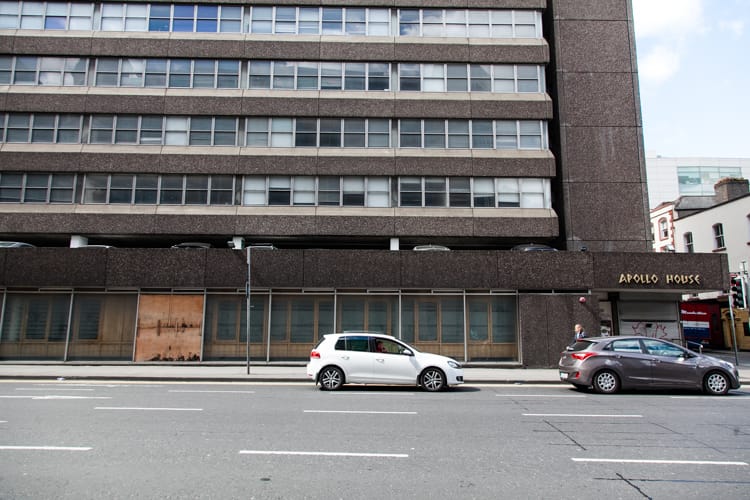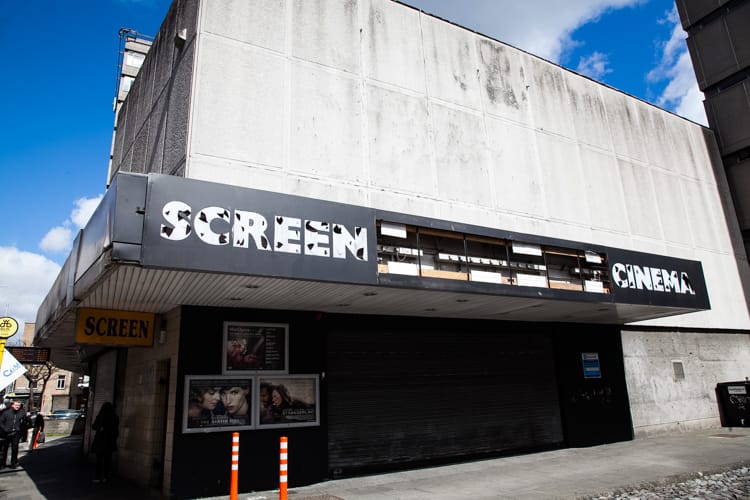What’s the best way to tell area residents about plans for a new asylum shelter nearby?
The government should tell communities directly about plans for new asylum shelters, some activists and politicians say.
The Screen cinema is closed, Hawkins House is to be demolished, and Luas tracks are being laid. What’s afoot around George’s Quay?

When James Brennan started to work at Tara Leathers on Tara Street in 1988, there were quite a few neighbouring shops.
“There was a photographer which turned into an auctioneers, there was a bookie next to that and there was a restaurant next door,” he said on Monday, as he set down a pair of newly repaired brogues. “They’re all gone.”
Since then, Brennan says, crime in the area seems to have fallen and drug-use has shifted away. But the area has become “much more transient and much more diverse,” he says. “There’s nothing really to hold people in the area.”
In 2012, the George’s Quay Local Area Plan was drawn up for the area around Tara Street, which set out how best to improve the neighbourhood across 16 city blocks.
It’s an area that falls between Hawkins Street and Lombard Street, close to government departments and Trinity College, and includes the now-closed Screen Cinema, the up-for-demolition Hawkins House, and the under-construction Luas tracks.
For now, though, there are only pockets of life there, and businesses with different takes on the gradual redevelopment of the area.
Local Area Plans are prepared for neighbourhoods that require economic, physical or social renewal and can accommodate large-scale development over time.
They have a lifespan of six years, which can be extended by the council to 10. And it’s looking likely an extension may be in order here.
If the reshape of the area is going to happen, it depends on the demolition or redevelopment of several structures.

Apollo House, College House, and the Screen Cinema are all now vacant and supposedly set for redevelopment. Hawkins House, headquarters of the Department of Health, is due to be dismantled but when exactly is still unknown.
According to Máire Ní Fhaircheallaigh, a spokesperson for the Office of Public Works, “It is intended to lodge a planning application in May 2016 for the redevelopment of the Hawkins House site, which would include demolition of the existing structure.”
The LAP, voted through in 2012, aims to provide mixed-use streets with retail and office space. But some businesses in the area don’t think much will change for them were regeneration to occur.
Mark Clinton, the proprietor of Mark’s Models shop on Hawkins Street, says his shop, which sells train sets and miniature models, is a “destination location”, and so he’s unlikely to be affected by any changes.
“This particular shop gets people from Limerick every day,” says Clinton. “Most of our customers are regulars, they’re not just walking by.”
The main tracks of the Luas Cross City run right alongside Clinton’s shop. He reckons that, at least, will show people that the street is here. “But there’s nothing really much on it,” he says.
The LAP set out to define the availability of public transport within the area, noting that between Tara Street and Pearse stations, the area is well serviced. It was proposed to install a number of dublinbike docks, which have yet to materialise.
A pedestrian route that will run from Christchurch Place through to the Hawkins House site and on to Tara Street was also proposed. The redevelopment of Hawkins House, says the LAP, will determine how this route will be configured and until then it’s unlikely any action will be taken to achieve this.
The office zone near Poolbeg Street and the river, says the LAP document, is “a congested and inhospitable place for pedestrians during the working day and is an inactive district after working hours”.
Well, not entirely inactive. Mulligan’s pub on Poolbeg and the adjacent Vintage Kitchen bring considerable numbers to the area most nights.
As the manager of Mulligan’s, Gary Cusack, tells it, they’re lucky they have the reputation they have in such a bleak quarter of the city.
Cusack isn’t hurried in Mulligan’s. It’s approaching midday as he leans against the wood panelling of the bar.
He recalls that a month ago workmen were seen marking off the utilities around the area. They found an ESB substation underneath Hawkins House, he says, which he reckons will stall any revamp.
The redevelopment, when it comes, Cusack thinks, will be good for the area.
“Business generates business,” he says. “We’re slap-bang in the city centre. Tara Street’s there, O’Connell Bridge is a two-minute walk. Grafton Street’s a two-minute walk. It’s probably one of the best prime sites in the city centre, and yet we’ve three or four ugly buildings.”
Although Cusack sees any rejuvenation of the area as a positive, he thinks that “the two, three years of knocking and building and cement lorries and dust and dirt” will wreck his head.

From Poolbeg Street towards Townsend Street, the grim structures multiply, and the untapped
potential of the area becomes evident. The LAP provides for a high-rise office block at the Tara Street Dart Station, 50 metres in height.
In March 2015, CIE sought a partner in order to develop an office block on the site. Johnny Ronan, the developer behind Treasury Holdings, has joined forces with the state-owned transport company to see the development take place, according to the Irish Examiner.
The LAP for the George’s Quay area notes an increasing demand for prime office space, something Dublin Chamber of Commerce’s media relations manager Graeme McQueen says is often discussed in his line of work.
“Redeveloping areas such as George’s Quay would go a long way to addressing the tight supply of office space in the city,” he says.
McQueen says that in Dublin 2 and Dublin 4, 600,000 sq ft is being developed for the next two years and 40 percent of this space has already been reserved.
It’s hard to say how fast the area will be redeveloped.
“The area has been dispossessed and [is] ripe for speculation,” says independent Dublin city councillor Mannix Flynn.
IMC cinemas, which closed the Screen in February, could not be reached for a comment on the sale of the building or its potential redevelopment.
The Luas Cross City, running up Hawkins Street, is due to be completed in 2017.
Planning permission for the Hawkins House site redevelopment is intended to be lodged in May, with no timeline given for demolition.